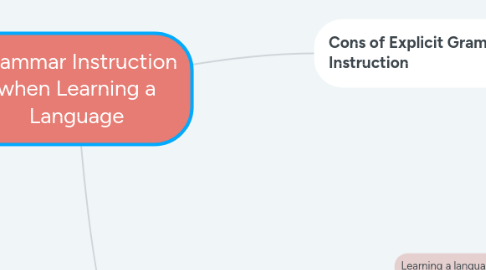
1. Pros of Explicit Grammar Instruction
1.1. Learning a language:
1.1.1. It is focused on the knowledge of the grammar rules of a language (grammar and syntax), helps to master the functioning of language.
1.2. Reveals Exceptions
1.2.1. It focuses on learning the order of words and irregular verbs in the English language, helps improve English as it is complexity.
1.3. Better for some, but not all
1.3.1. It is focused on people who are better explicit learners, since they are able to learn and adopt grammar explicitly.
1.4. Better for adult learners:
1.4.1. . “Formal” language learning seems to be a better approach for adult learners.
2. Cons of Explicit Grammar Instruction
2.1. Acquiring a language
2.1.1. It is to improve "learn a language" or come to a practical use of a foreign language. It implicitly helps the student to prepare for real and communicative situations where the rules are often forgotten or broken.
2.2. Achieving fluency
2.2.1. It is the way we acquire our first language at an early age. Therefore, it promotes the acquisition of basic language skills that are essential for language in practical and real situations.
2.3. Promoting actual memorization
2.3.1. By promoting "knowledge of the rules", it encourages a superficial acquisition of language (memorization). Without knowing how to apply them, the rules are practically useless.
